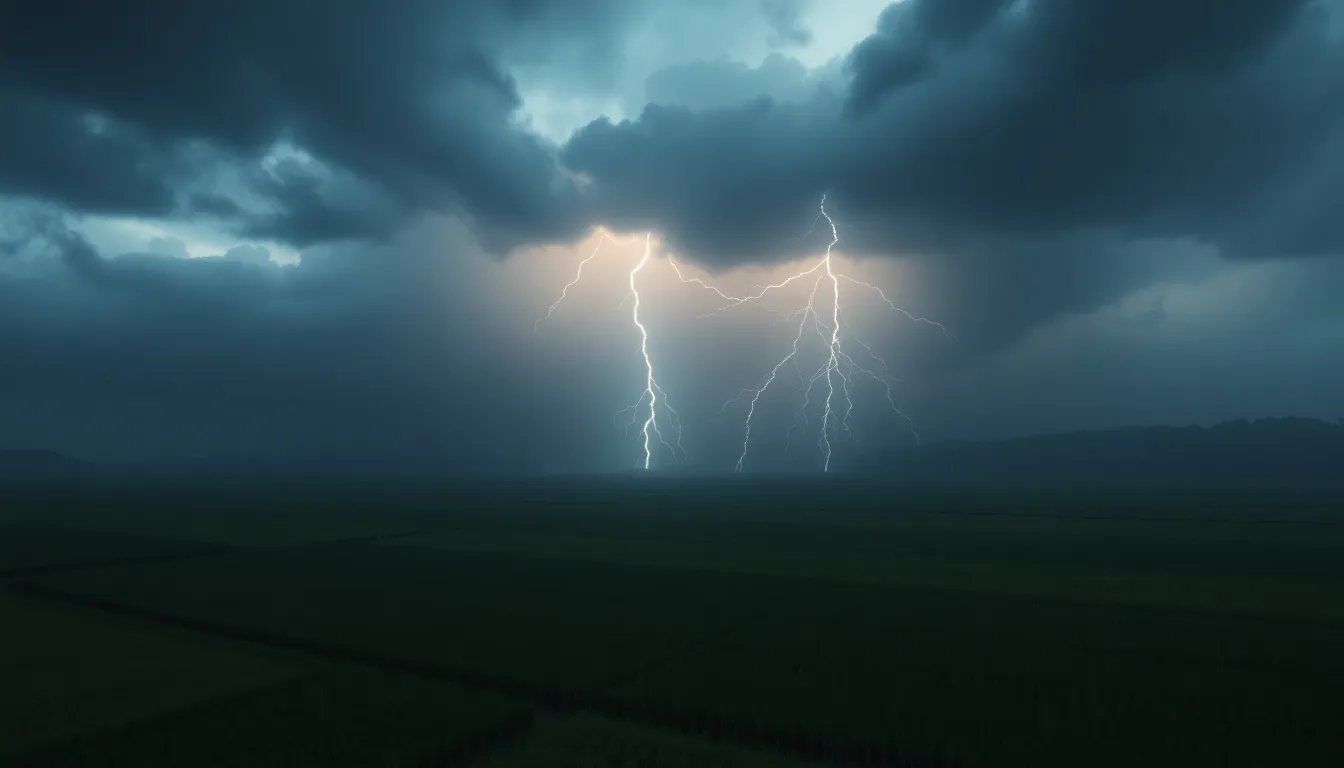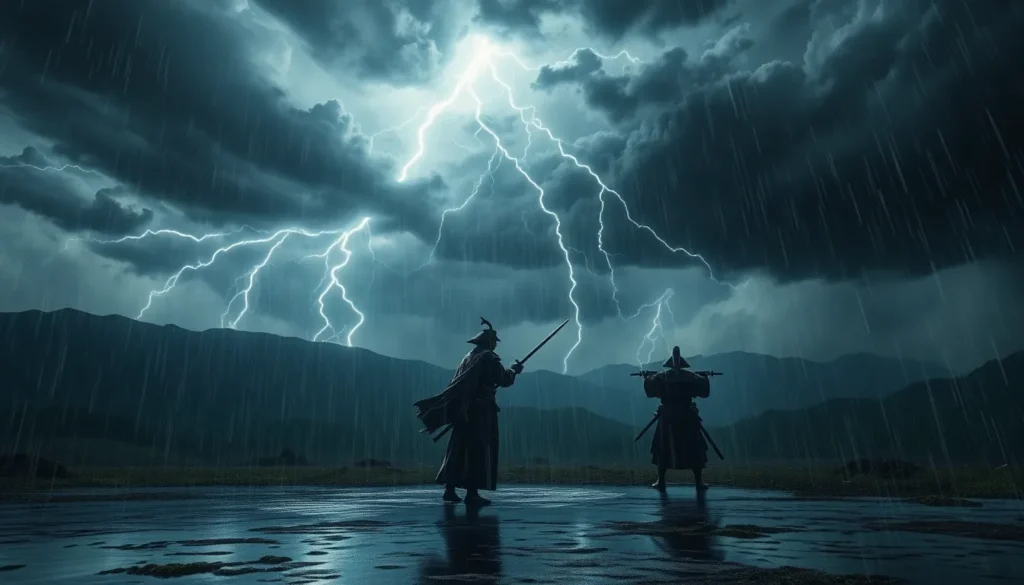Table of Contents
ToggleIn the breathtaking world of Ghost of Tsushima, storms aren’t just a backdrop; they’re a dramatic character in their own right. Imagine galloping through lush landscapes while thunder rumbles ominously overhead, making you feel like you’re in an epic samurai movie. The thunderstorm mechanic adds an electrifying twist, turning ordinary gameplay into a cinematic experience that leaves players on the edge of their seats.
But it’s not just about the visuals. These storms can change the tide of battle, creating a unique blend of strategy and chaos. So grab your controller and prepare for a wild ride, because when the skies darken, it’s not just rain that’s falling—it’s the thrill of adventure. Whether you’re a seasoned warrior or a curious newcomer, the thunderstorm in Ghost of Tsushima promises to keep you entertained and maybe even a little soaked.
Overview of Ghost of Tsushima Thunderstorm
Thunderstorms in Ghost of Tsushima play an essential role in shaping the game’s narrative and atmosphere. These storms serve as dramatic elements, enhancing the overall immersive experience for players. They produce a cinematic backdrop that aligns with the game’s epic samurai theme.
Visually, thunderstorms create a stunning effect, with lightning illuminating the landscape and rain cascading down during battles. The mechanics of the storm introduce unpredictability, challenging players to adapt their strategies in real-time. Players encounter heightened tension as sounds of thunder rumble in the distance, signaling an imminent storm.
During combat, thunderstorms add intensity, transforming standard encounters into chaotic and memorable moments. The unpredictable weather influences visibility and maneuverability, creating a dynamic battlefield environment. Players often find that stormy conditions require quick thinking and agility, pushing their skills to the limit.
Moreover, feelings of suspense accompany each storm. The weather’s volatility mirrors the game’s themes of honor and struggle. The ability to harness the storm’s power during gameplay resonates with the game’s deep connection to nature and its elements.
Environmental storytelling thrives during these storms, with frequent visual and audio cues reinforcing the narrative depth. Through the use of dramatic weather patterns, Ghost of Tsushima elevates its storytelling and gameplay, creating a lasting impression on players. The thunderstorm mechanic stands out, appealing to both seasoned players and newcomers eager for an exhilarating experience.
Visual Impact

Thunderstorms in Ghost of Tsushima create a powerful visual impact that captivates players. The interplay of rain, lightning, and dark clouds brings a level of realism that enhances immersion.
Graphics and Design
Visual fidelity showcases how thunderstorms can transform landscapes. Players encounter vivid details where rain pours and lightning strikes. Each droplet reflects light, creating dynamic surfaces. Atmospheric lighting alters scenery during thunderstorms, casting dramatic shadows and highlighting textures. In battle, the unique visual elements emphasize the intensity of combat, capturing pivotal moments. Characters stand out against the stormy backdrop, enhancing narrative engagement through striking contrasts.
Atmospheric Effects
Sound design complements graphics, enhancing the storm’s impact. Crashing thunder and pouring rain create immersion that feels palpable. The fluctuating weather also influences gameplay dynamics, as visibility changes during thunderstorms. Related visuals, like flashes of lightning, signal shifts in tension and urgency. Players adapt strategies in response to these atmospheric cues, heightening engagement. Furthermore, moods fluctuate with the weather, aligning with the game’s themes of honor and internal struggle. Thunderstorms effectively become a character in their own right, deepening the storytelling experience.
Gameplay Elements
Thunderstorms play a vital role in shaping the gameplay dynamics of Ghost of Tsushima. They introduce unique mechanics that enrich the combat experience and enhance immersion.
Thunderstorm Mechanics
Thunderstorms alter environmental conditions significantly. Rain reduces visibility, compelling players to adapt their strategies. Lightning strikes can illuminate surroundings, providing brief moments of clarity during battles. These weather changes impact movement and reaction times, adding an unpredictable element to encounters. The dynamic nature of the storms ensures no two moments feel the same. Players face challenges that require real-time adjustments to techniques and approaches. With each clap of thunder, the stakes rise, making every decision critical during skirmishes.
Influence on Player Experience
Players experience heightened emotions during thunderstorms. The atmospheric sounds of rain and thunder create an immersive backdrop. This aural landscape not only captivates players but also enhances tension during critical moments. Combat sequences become more thrilling as environmental shifts occur unexpectedly. As players navigate the stormy conditions, they find themselves invested in the storyline. The storms serve as a reminder of nature’s power, reinforcing themes of honor and struggle. Each encounter is not just a battle; it transforms into a memorable experience shaped by the tempest.
Narrative Integration
Thunderstorms play a significant role in shaping the narrative of Ghost of Tsushima. Their presence profoundly influences storytelling, immersing players in the game’s world.
Storytelling Through Weather
Weather dynamics serve as a storytelling tool, where storms enhance emotional resonance. The dramatic shifts in weather conditions mirror Jin’s internal struggle, reinforcing themes of conflict and honor. Frequent downpours and flashes of lightning punctuate key moments, amplifying tension during pivotal battles. The constant change invites players to engage with the environment, making every storm feel distinct and significant. Shifts in visibility and sound deepen immersion, as the natural elements create a sense of urgency. This storytelling technique immerses players in Jin’s journey, making them feel the weight of each decision.
Symbolism of Storms
Storms symbolize inner turmoil and external conflict, reflecting Jin’s path toward becoming a samurai. Each thunderclap resonates like the consequences of choice, emphasizing turmoil and chaos. The unpredictable nature of storms mirrors Jin’s struggle against the Mongol invaders and his cultural heritage. As players navigate the tempestuous environment, they’re reminded of his commitment to honor and redemption. Thunderstorms create more than a visual spectacle; they represent growth during adversity. Players experience transformation alongside Jin, feeling empowered as they adapt to the challenges presented by the storms.
Community Reactions
Players consistently express admiration for the thunderstorms in Ghost of Tsushima. Feedback highlights the storms as impactful elements that elevate the gameplay experience. Many players note the way dynamic weather changes the atmosphere, creating an immersive environment. Adapting tactics during thunderstorm events becomes a thrilling challenge.
Player Feedback
Comments from the community often mention the tension thunderstorms add to battles. Players feel that the unpredictability of weather influences their strategy, pushing them to react quickly. Users appreciate the realism thunderstorms bring, noting how lightning flashes enhance critical moments. Expressions of excitement arise when players encounter storms, describing them as unforgettable experiences that heighten emotional engagement with the storyline.
Fan Creations Inspired by Thunderstorms
The game’s thunderstorms inspire a variety of fan creations. Artists frequently share stunning artwork depicting stormy landscapes and epic battles illuminated by lightning. Unique mods emerge, enhancing in-game weather effects to mimic real-life storms. YouTube channels showcase gameplay highlights featuring dramatic thunderstorm encounters, captivating viewers with dynamic visuals. These creative expressions underline the vibrant community formed around Ghost of Tsushima, centered around its breathtaking storm scenes.
Thunderstorms in Ghost of Tsushima are more than just a backdrop; they’re integral to the game’s immersive experience. Their dynamic nature challenges players to adapt and strategize in real-time, enhancing the thrill of combat. The stunning visuals and immersive sound design create a captivating atmosphere that resonates with the game’s themes of honor and struggle.
As players navigate through the stormy landscapes, they’re drawn deeper into Jin’s journey, feeling the weight of each decision amplified by the tempest around them. The community’s appreciation for these weather dynamics further illustrates their significance, showcasing how thunderstorms have become a beloved aspect of the game. Ultimately, they leave a lasting impression, enriching the narrative and gameplay for everyone involved.







